Legislative Analyst's Office
February 22, 1995

The budget proposes General Fund expenditures of $5.3 billion for higher education in 1995-96. This is $163 million, or 3.2 percent, more than estimated expenditures in the current year. Including local property taxes, the budget proposes spending of $6.7 billion, which is $177 million, or 2.7 percent, more than estimated expenditures in the current year.
Figure 1 (see next page) shows that higher education expenditures from the General Fund have decreased by $148 million since 1988-89, representing an average annual decrease of 0.4 percent. When these expenditures are adjusted for inflation, General Fund spending decreased over this time period by an average of 3.4 percent annually. The share of General Fund spending allocated to higher education has declined from 15 percent to 13 percent over this period.
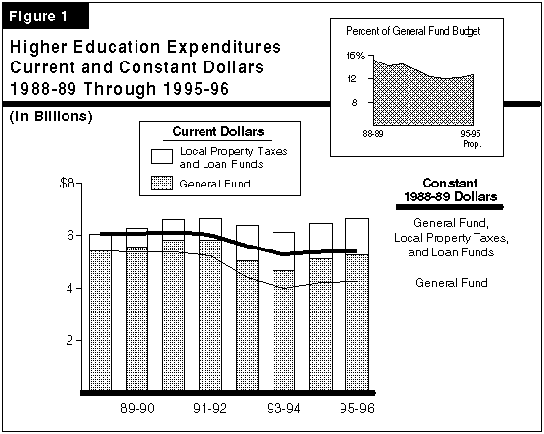
Including local property taxes, and loan funds, higher education expenditures have increased by $580 million over the period, an average annual increase of 1.3 percent. Adjusted for inflation, spending has decreased an average of 1.8 percent annually.
Figure 2 shows spending from the General Fund, local taxes, loan funds, and student fee revenues (net of financial aid) in detail. The figure shows that the budget proposes modest increases for each segment of higher education.
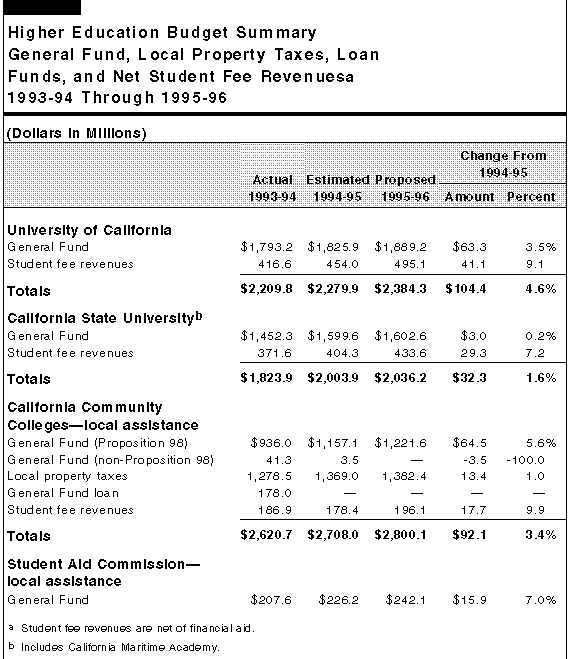
For the University of California (UC) and the California State University (CSU), the budget proposes General Fund increases of $63.3 million (3.5 percent) and $3 million (0.2 percent), respectively. (As we show in Figure 3 below, the CSU figure understates actual budget-year growth, as the 1994-95 expenditures were high due to one-time spending. This issue is discussed further in our analysis of the CSU budget.)
The budget anticipates that fees will increase by at least 10 percent at the UC and CSU. Assuming a fee increase of 10 percent, combined General Fund and net student fee revenues would increase by $104 million (4.6 percent) at the UC and by $32 million (1.6 percent) at the CSU.
For the California Community Colleges (CCC), the budget proposes to increase support from the General Fund in 1995-96 by $61 million (5.3 percent) and from combined General Fund, property tax revenues, and net student fee revenues by $92 million (3.4 percent). The budget proposes to raise fees from $13 per credit unit to $15 per credit unit, an increase of 15 percent.
Figure 3 presents the major budget changes in General Fund spending for higher education. For the UC and the CSU, the largest proposed General Fund increases ($37 million at UC and $31 million at CSU) are for unspecified two percent increases in general purpose expenditures.
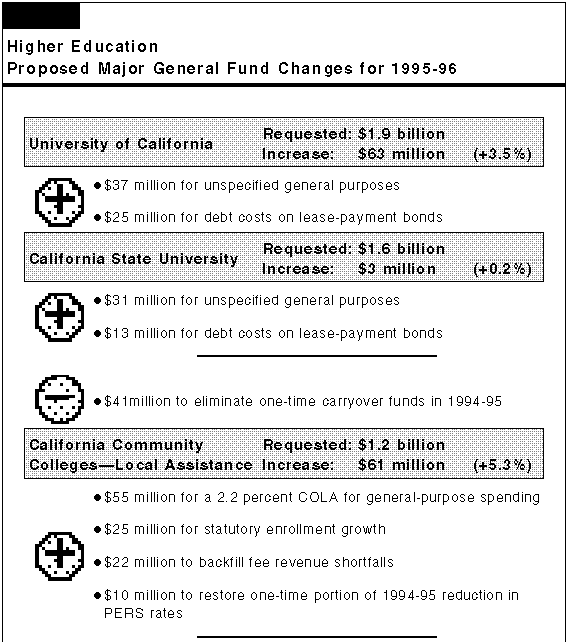
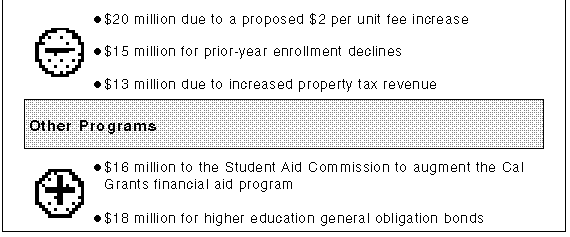
Funding for debt service costs on previously authorized lease-payment bonds also accounts for a significant portion of the net General Fund increases at the UC and the CSU $25 million and $13 million, respectively. For the community colleges, the budget proposes $4.9 million for these costs.
The budget funds a net General Fund increase of $61 million for the community colleges. The budget proposes an increase of $55 million to fund a 2.2 percent COLA for general-purpose spending. An additional $25 million is provided to fund statutory enrollment growth, but is partially offset by a $15 million reduction related to enrollment declines among bachelor's degree holders in prior years.
Other major funding increases for the community colleges include $22 million to backfill fee revenue shortfalls primarily 1994-95 revenue losses not backfilled in the current year and $10 million to restore a current-year funding reduction that recognized a one-time decrease in employer rates charged by PERS. These increases are offset by $33 million in reductions that are related to funding source shifts: $20 million due to a proposed $2 per unit fee increase, and $13 million due to increased property tax revenue. For the first time in recent years, the budget proposes to backfill current-year property tax shortfalls in the current year, instead of waiting until the budget year.
Figure 4 shows student enrollment at each of the segments. It shows that enrollments have declined at all the segments from 1992-93 to 1994-95. These declines are probably due to a number of factors, including course section reductions, fee increases, declines in the economy generally, and actions taken by the institutions to limit enrollment. The UC's full-time-equivalent (FTE) enrollment declined from 154,277 in 1992-93 to an estimated 149,481 in 1994-95, which is a 4,796, or 3.1 percent, decrease. The CSU's FTE enrollment declined from 259,309 in 1992-93 to an estimated 250,498 in 1994-95, which is a 8,811, or 3.4 percent, decrease.
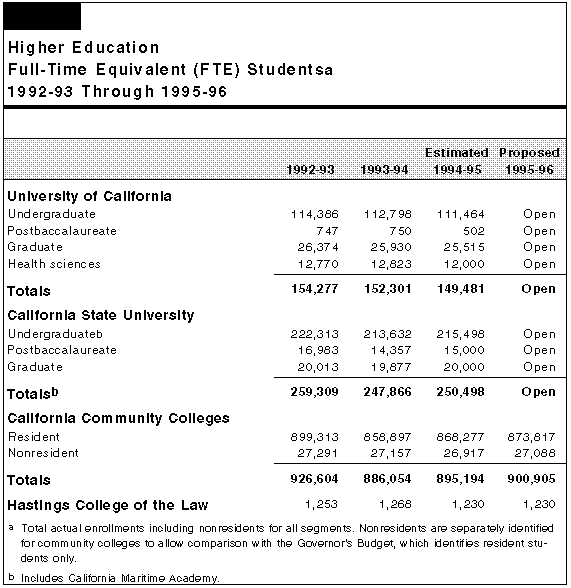
For the third year in a row, the administration does not propose budget-year enrollment levels for the UC and the CSU. Later in this Analysis, we discuss UC and CSU enrollment levels and their relationship to the state's Master Plan for Higher Education.
The community colleges have also experienced declines in total enrollments since 1992-93. Total actual FTE enrollment declined from 926,604 in 1992-93 to 895,194 in 1994-95, which is a 31,410, or 3.4 percent, decrease. The budget proposes enrollments of 873,817 resident FTE in 1995-96, which represents an increase of 5,540, or 0.6 percent from the current-year level. This is the net effect of an increase of 8,596 FTE students due to adult population growth of one percent and a decrease of 3,056 FTE students to reflect estimated attrition related to the proposed fee increase.
Figure 5 (see next page) presents student fee levels from 1992-93 through 1995-96. The budget indicates that it is expected that general student fees will increase by at least 10 percent at UC and CSU. Accordingly, Figure 5 displays the fee levels assuming an increase of 10 percent. For the community colleges, the budget proposes an increase in fees from $13 per credit to $15 per credit unit. For the CSU and the CCC, increasing student fees requires legislation.
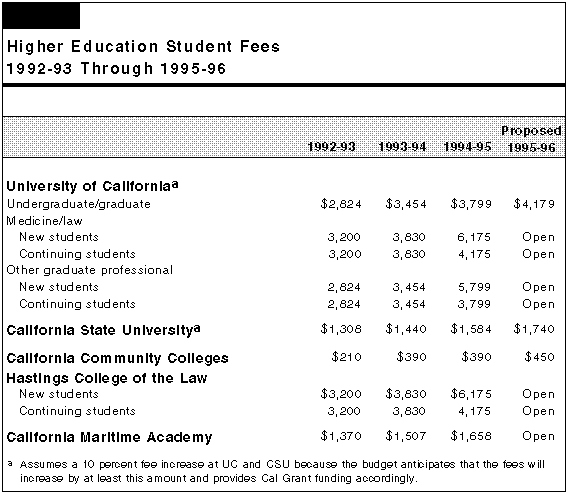
From 1992-93 through 1994-95, fees have increased significantly at all three segments. Student fees rose at the UC by $975 (35 percent), at the CSU by $276 (21 percent), and at the CCC by $180 (86 percent). Despite these large increases, the budget estimates that current UC undergraduate resident student fees are $241 less than the average fee of the four public universities with which the UC compares itself on faculty salaries. The budget estimates that current CSU fees are $1,046 lower than the average fee of the 15 public universities with which the CSU compares itself on faculty salaries. The budget also shows that California's current community college fees are still the lowest in the nation.